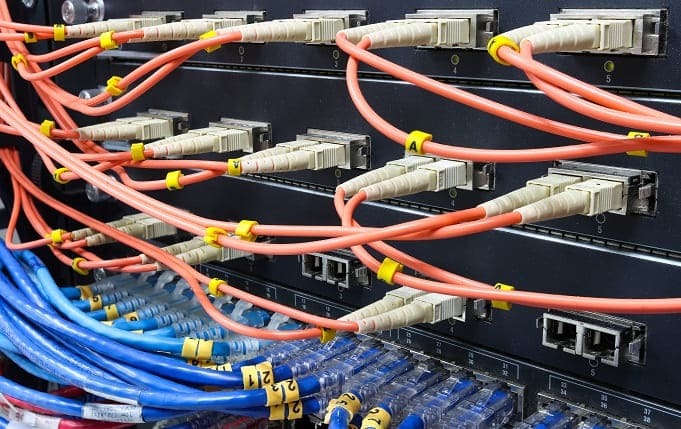
 Data Structure
Data Structure Networking
Networking RDBMS
RDBMS Operating System
Operating System Java
Java MS Excel
MS Excel iOS
iOS HTML
HTML CSS
CSS Android
Android Python
Python C Programming
C Programming C++
C++ C#
C# MongoDB
MongoDB MySQL
MySQL Javascript
Javascript PHP
PHP
- Selected Reading
- UPSC IAS Exams Notes
- Developer's Best Practices
- Questions and Answers
- Effective Resume Writing
- HR Interview Questions
- Computer Glossary
- Who is Who
What is the full form of FSN?
Introduction
Full-Service Network is referred to as FSN. Early in the 1990s, AT&T undertook an experimental effort to build a high-speed, fiber-optic network that could deliver a range of services, such as phone, video, and data transfer, over a single network.

The FSN was created to be an all-digital, broadband network that could provide clients cutting-edge services in a time- and money-saving way. Even though the FSN project ultimately failed, it was a significant step in the advancement of broadband technology and helped the telecommunications sector expand.
History of FSN
In an ambitious endeavour to develop a cutting-edge broadband network that could deliver phone, video, and data services over a single network, AT&&T launched the Full- Service Network (FSN) project in 1993. The FSN was created as an all-digital, fiber-optic network that would provide users with unmatched speed and dependability.
The objective of the FSN project, which was started in Orlando, Florida, was to show that a high-speed, all-digital network was both technically and economically feasible. AT&&T made significant investments in the project, laying more than 5,000 miles of fiber- optic cable and setting up cutting-edge switching and transmission machinery.
The FSN project ran into several technical and financial challenges, such as the challenge of integrating many service types across a single network, the high cost of the equipment, and the challenge of convincing users to migrate to the new network. Despite these difficulties, AT&&T persisted in funding the endeavour in an effort to make it a successful enterprise.
However, it became obvious in the late 1990s that the FSN project would not be successful. The FSN project was cancelled by AT&&T in 1998, and the company wiped down its $1.4 billion investment.
Despite its failure, the FSN project was a significant step forward for the telecommunications sector and the advancement of broadband technology. It highlighted the technical difficulties and the need of meticulous preparation and execution in the establishment of cutting-edge networks. The FSN project also helped the Internet expand and give rise to cutting-edge technology that would ultimately change the telecoms sector.
Components of FSN
A comprehensive telecommunications system called the Full-Service Network (FSN) planned to deliver a range of services, such as phone, data, and video transmission, via a single all-digital network. The FSN comprised several key components, including
Fiber-optic Cable The fiber-optic backbone upon which the FSN was built allowed for the high-speed, dependable transmission of data, audio, and video signals across extensive distances.
Digital Switching and Transmission Equipment To control and move the traffic on the network, the FSN employed sophisticated digital switching and transmission tools, such as ATM (Asynchronous Transfer Mode) switches and SONET (Synchronous Optical Network) tools.
Service Integration The FSN's capacity to combine several service kinds, such as voice, video, and data, across a single network was one of its primary strengths. The FSN was able to manage various services on the same network thanks to the adoption of cutting-edge service integration technologies.
Customer Premises Equipment Customers need specialised hardware, such as digital set-top boxes for television services and high-speed modems for data services, to access the FSN.
Interactive Services Video-on-demand, interactive television, and interactive gaming are just a few of the interactive services that the FSN was created to offer. The FSN's high-speed, all-digital network infrastructure allowed for the provision of these services.
Together, these elements made it possible for the FSN to offer a variety of advanced services across a single network, making it a bold and innovative undertaking that aided in the creation of contemporary telecommunications infrastructure.
Applications of FSN
In order to provide a variety of cutting-edge telecommunications services across a single all-digital network, the Full-Service Network (FSN) was created. Some of the applications of the FSN included
Voice Services The FSN offered users cutting-edge capabilities like voice messaging and call forwarding while providing high-quality, dependable phone services through a digital network.
Video Services Over a fast, all-digital network, the FSN provided customers with video services such as interactive television and video-on-demand.
Data Services Customers were able to access the Internet and other online services at a quicker rate because to the FSN's high-speed data services, which were delivered across a fiber-optic backbone.

Interactive Services The FSN was created to provide a variety of interactive services that needed a fast, dependable network infrastructure, such as interactive gaming and distant learning.
Integrated Services The FSN's capability to combine many service kinds, including phone, video, and data, across a single network was one of its primary characteristics. This eliminated the need for several service providers by enabling users to access various services over the same network.
The FSN was a large-scale initiative that sought to provide a full range of cutting-edge telecommunications services via a single all-digital network. Despite the project's eventual failure, it made a significant contribution to the growth of contemporary telecommunications infrastructure and paved the way for the high-speed, entirely digital networks that are now the norm.
Conclusion
Early in the 1990s, AT&T undertook the ambitious Full-Service Network (FSN) project to build an all-digital, fiber-optic network that could deliver a variety of sophisticated telecommunications services across a single network. Despite the project's numerous technical and financial challenges and eventual failure, it was a significant step in the advancement of contemporary telecommunications infrastructure. The fast, all-digital networks that the FSN sought to establish are now widespread and give users access to a variety of high-tech telecommunications services, such as high-speed data, phone, and video services.
FAQs
Q 1 What was the Full-Service Network?
Ans: Early in the 1990s, AT&&T undertook the ambitious Full-Service Network (FSN) project to build an all-digital, fiber-optic network that could deliver a variety of sophisticated telecommunications services across a single network.
Q 2 Why did the Full-Service Network ultimately fail?
Ans: The Full-Service Network had a number of technical and financial hurdles, including high rollout costs and technological issues combining several services across one network. Together with increased competition from other service providers, a combination of these factors ultimately led to the project's failure.
Q 3 What was the legacy of the Full-Service Network?
Ans: Despite its eventual failure, the Full-Service Network made a significant contribution to the growth of contemporary telecommunications infrastructure and paved the way for the high-speed, all-digital networks that are widespread today. The contemporary telecommunications network that supports our connected world carries on the FSN's history.

